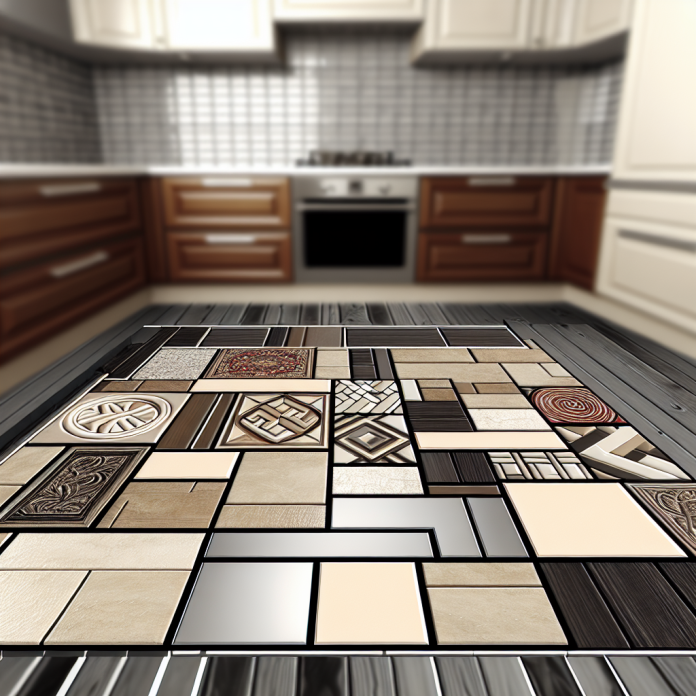Are you looking for guidance on achieving a smooth and stylish kitchen tile to wood floor transition? This unique flooring challenge can seem daunting, as many Orange County homeowners struggle to find effective tile to wood transition ideas that enhance their space. Thankfully, with a variety of creative kitchen flooring solutions available, you can easily find an option that complements your Orange County home’s decor. Whether you prefer modern floor transition strips or custom floor designs, there are plenty of ways to blend hardwood and tile floors seamlessly. Let’s explore these innovative ideas to elevate the appeal of your living space!
Transitioning from tile to hardwood in your Orange County kitchen or other living areas offers a fantastic opportunity to enhance both functionality and aesthetics. Many homeowners in Orange County are keen on discovering unique methods to unite different flooring types, whether it be through innovative geometric designs or eye-catching metal strips. Utilizing various flooring materials can not only improve visual flow but also create distinct zones in open-concept spaces. With an array of transition solutions available, from glass mosaics to custom tiles, you can transform your floors into a personalized design statement. This guide will unveil multiple approaches to help you navigate this flooring transformation with ease.
Amazing Kitchen Tile to Wood Floor Transition Ideas
When considering the transition between your kitchen tile and wood floors, it’s essential to explore innovative ideas that combine aesthetics with functionality. One exciting option is to use metal transition strips that not only provide a sleek finish but also create a distinctive visual separation between the two materials. Available in various finishes, these strips can be customized to fit different design themes while ensuring a smooth transition that enhances the overall decor.
Another creative idea is to incorporate geometric flow transitions. This approach involves arranging tiles in a geometric pattern that guides the eye from the tile section to the wood floor. It creates a harmonious flow that accents both materials beautifully, making the transition seamless and inviting. Homeowners often appreciate this design flexibility as it allows for unique self-expression in their kitchen layouts.
Creative Floor Transition Strips for Unique Designs
Floor transition strips are an indispensable tool when it comes to bridging the gap between tile and wood floors. They come in various materials, including rubber, aluminum, and wood, allowing for customization according to the surrounding aesthetics. Utilizing these strips can help manage height differences while providing a finished look that keeps dirt and debris from collecting in the seams.
Beyond the practical aspects, a well-chosen transition strip can enhance the character of your flooring. For instance, a contrasting color strip can draw attention to the transition point, making it a design feature rather than a mere necessity. This strategy not only reflects modern creative flooring but also showcases the unique blend of hardwood and tile typically found in contemporary kitchens.
Inspiring Ideas for Mixing Tile and Wood Floors
Combining tile and wood floors opens up endless creative design avenues. One popular method is mixing tiles and hardwood boards of equal sizes to achieve a cohesive look that flows naturally. By segmenting these spaces effectively, homeowners can define areas without adding visual clutter – this method is particularly effective in open-concept designs commonly found in Orange County homes.
Another compelling approach is the use of tile inlays to create a stunning focal point in your flooring. This technique involves incorporating patterned tiles into the wood flooring at transition points, which can light up the areas between rooms while effortlessly guiding movement throughout the space. The key is to choose colors and patterns that complement wood tones, enhancing the visual appeal and coherence of the overall design.
Balancing Uneven Floors: Solutions and Ideas
Uneven floors can present a significant challenge when transitioning between tile and wood materials. To overcome this, Orange County homeowners can explore options such as end cap transitions, which bridge height discrepancies and create a smooth transition across different flooring types. These end caps provide a seamless look while ensuring safety and comfort, making transitions more practical for everyday use.
For homeowners facing drastic height differences, T-track transitions are another innovative solution. This option allows for easy integration of flooring materials at varying levels while maintaining a minimalistic and clean appearance. T-tracks can be easily installed and available in various finishes, ensuring that they blend well with both tile and wood floors, enhancing the overall aesthetic.
The Aesthetic Appeal of Square Floor Tiles and Wood Flooring
Square floor tiles offer a timeless appeal that can significantly enhance the look of your kitchen. Pairing square tiles with wood flooring can create an elegant and sophisticated atmosphere. By designing a layout that incorporates these squares in an alternating pattern with wood, homeowners can achieve a pleasing visual rhythm that draws the eye and invites guests into the space.
In addition to aesthetics, square tiles can also provide practical benefits, such as ease of cleaning and maintenance. When combined with wood floors, they can effectively demarcate areas, offering a visual hierarchy that helps define kitchen zones, entertainment spaces, and walkways. This combination not only enhances the utility of the area but also elevates its design.
Custom Floor Designs: Crafting Your Unique Style
Custom floor designs allow Orange County homeowners to express personal style and creativity in their home decor. By blending tiles that mimic wood with actual hardwood, individuals can create a hybrid flooring solution that is both visually stunning and functionally superior. This unique combination opens opportunities for personalized designs, seamlessly integrating wood’s warmth with tile’s versatility.
Furthermore, homeowners can push the boundaries of traditional flooring by experimenting with unconventional borders and custom patterns that reflect their unique tastes. Using a mixture of tiles in various colors or textures can yield eye-catching transitions that make the kitchen a centerpiece of the home. It’s an exciting approach that enriches the living experience while providing practical solutions for how to merge different flooring materials.
Final Thoughts: Achieving a Stylish Transition
Achieving a seamless kitchen tile to wood floor transition is primarily about careful planning and creative design choices. Homeowners must consider the heights and textures of both materials to avoid visual dissonance. Additionally, employing various transition strategies—from metal strips to custom inlays—can make the process more than just about function, transforming it into an integral part of your home’s style.
Ultimately, the goal is to create a transition that not only looks fabulous but also feels comfortable underfoot. The right flooring combination can enhance your home’s design while increasing its market value. A well-executed transition reflects a homeowner’s attention to detail and commitment to achieving a cohesive aesthetic, leaving a lasting impression on guests.
Frequently Asked Questions
What are some popular kitchen tile to wood floor transition ideas?
Some popular kitchen tile to wood floor transition ideas include using metal transition strips for a sleek look, creating customized geometric flow transitions, and mixing tiles and hardwood boards for an interesting design. These ideas help to blend various flooring options seamlessly and enhance the overall aesthetics of your kitchen.
How do I choose the right transition strips for hardwood and tile floors?
When choosing transition strips for hardwood and tile floors, consider the height difference between the two materials, the overall design of your kitchen, and the material of the strip itself. Metal and wood strips are popular choices that offer durability and style, making them ideal for kitchen tile to wood floor transitions.
What are creative kitchen flooring options for tile to wood transitions?
Creative kitchen flooring options for tile to wood transitions include tile inlays, square floor tiles, and unique blending of different tile colors. These designs allow for artistic expression and make the transition area a focal point in your kitchen.
Are there specific installation techniques for floor transition strips?
Yes, installation techniques for floor transition strips can vary depending on the type of strip used. Generally, you may need to measure the gap between flooring, use adhesive or nails to secure the strip, and ensure it meets the flooring flush to avoid tripping hazards. For best results, follow manufacturer instructions or consult a professional.
Can I install a kitchen tile to wood floor transition myself?
Yes, many kitchen tile to wood floor transition projects are suitable for DIY enthusiasts. If you’re comfortable with basic tools and have a good understanding of measuring and cutting, you can successfully install transition strips. However, for complex designs or significant height differences, hiring a professional is recommended.
What should I do about height issues between tile and hardwood during transition?
To address height issues between tile and hardwood during transitions, ensure you choose flooring materials that are similar in thickness. If there are significant height differences, consider using transition strips designed for uneven surfaces, or consult a professional installer for solutions that ensure a smooth transition.
What are the benefits of customizing floor transitions in a kitchen?
Customizing floor transitions in a kitchen allows homeowners to express their personal style, create unique designs, and seamlessly blend different flooring types. This approach can enhance the overall aesthetics of the space and ensure that the transition appears intentional and well-planned.
How can I maintain and clean kitchen floor transitions?
Maintaining and cleaning kitchen floor transitions involves regular sweeping and mopping to prevent dirt buildup. For specific transition strips, use a damp cloth or appropriate cleaner to ensure they remain in good condition. Avoid using harsh chemicals that could damage the materials.
What are the advantages of using metal transition strips for kitchen flooring?
Metal transition strips offer durability, a modern look, and the ability to withstand heavy foot traffic. They come in various finishes that can complement both tile and wood flooring, making them an excellent choice for kitchen tile to wood floor transitions.
Are there environmental considerations when choosing flooring for kitchen transitions?
Yes, when choosing flooring for kitchen transitions, consider sustainable materials, certifications like EPA or FSC, and the overall environmental impact of the flooring options. Opting for eco-friendly products can reduce your carbon footprint and contribute to a healthier living space.
| Transition Idea | Description |
|---|---|
| Metal Transition Strips | Utilize metal strips to create a clean border between tile and wood floors, available in various finishes. |
| Customized Geometric Flow Transition | Define tile designs in geometric patterns to create smooth transitions in style and flow. |
| Mix Tiles and Boards of Equal Size | Blend tiles and wooden boards to highlight distinct flooring types using modern design. |
| Tile Inlays | Incorporate tile inlays for dramatic textures that enhance the overall decor with ease of maintenance. |
| Square Floor Tiles | Design square tiles in matching colors to create an elegant and simple floor transition. |
| Glass Mosaic Tiles | Add glass mosaic tiles for a unique, glossy finish that provides striking visuals. |
| Unique Tile Blending | Mix various tile colors to craft a custom pattern, giving a personalized touch to transitions. |
| End Cap Transition | Utilize an end cap strip to fill gaps and define areas within rooms for easy maintenance. |
| When Floors Go Through Doors | Employ thin strips to match floors at doorways, perfect for managing moisture. |
| T-track Transitions | Design a T-track to manage transitions smoothly, enhancing accessibility and aesthetics. |
Summary
In summary, a kitchen tile to wood floor transition can dramatically enhance the appearance and functionality of your home. By exploring creative ideas, such as metal strips, geometric flows, or custom blending, you can achieve a seamless and beautiful transition that suits your style. Above all, ensuring the right thickness and addressing height issues will lead to a smooth finish that is visually appealing and easy to maintain.
Source: https://homeyimprovements.com/kitchen-tile-to-wood-floor-transition-ideas/
### Orange County Homeowners: Transform Your Space with Expert Remodeling
In the ever-evolving landscape of home renovation, Orange County stands out as a vibrant hub of opportunities for both homeowners and contractors. With a median home value of $1.18 million, affluent residents in cities like Laguna Beach, Newport Beach, and Irvine are increasingly looking to invest in high-value renovations ranging from $50,000 to $500,000. Whether you’re contemplating a modern kitchen upgrade or a luxurious bathroom renovation, the demand for skilled OC contractors has never been higher.
### Understanding the OC Remodeling Market
The Orange County remodeling market is uniquely influenced by its affluent demographics and consistent climate, making it an ideal location for outdoor living enhancements and energy-efficient upgrades. Homeowners in Costa Mesa and Huntington Beach are particularly interested in creating seamless indoor-outdoor spaces to take full advantage of their beautiful surroundings. As a contractor, tapping into this trend not only meets current homeowner desires but positions you as a leader in sustainable, desirable renovation solutions.
### Navigating California Building Codes and Permitting
For contractors, understanding California’s building codes and permit requirements is crucial in ensuring that all renovations comply with local regulations. In cities like Newport Beach, certain coastal building constraints apply, and familiarizing yourself with these can prevent costly delays in your projects. Being able to navigate these complexities confidently elevates your credibility with clients and can open doors for additional referral business.
### Local Contractor Opportunities in Orange County
As the demand for remodeling services continues to surge, local contractors have abundant opportunities to expand their business. Engaging in partnerships with local suppliers not only enhances your material offerings but also fosters community relationships—two key components in building a reputable brand. Furthermore, offering tailored options that cater to the unique lifestyles of Orange County residents, such as eco-friendly materials or smart home technology integrations, can set your services apart from the competition.
### Connect with OC Homeowners and Elevate Your Business
As Orange County homeowners invest more in their spaces, it’s an opportune time for contractors to position themselves as trusted advisors in the remodeling process. By sharing expert advice on social media platforms and engaging in local home shows, you can further establish your presence in the community. Remember, successful transformations begin with a solid relationship between the contractor and the homeowner, so be accessible, trustworthy, and ready to inspire. #OCremodeling #OCcontractors


